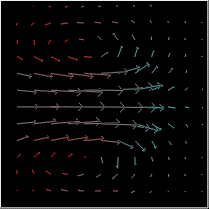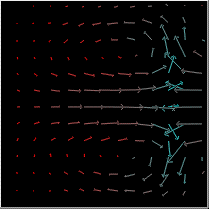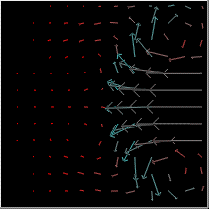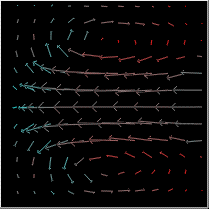Despite the fact that we store of course also key frames, the behaviour of an instance of TimeStep is that of a dynamic process: methods send to such an instance act on the instance as a whole, only the instance knows what kind of activities will be released after having receipt a message.
We will further on examine the underlying data structure for a significant application. Therefore let us briefly inspect a large class of applications from the calculus in continuum mechanics. Our intention is to focus on the numerical solving of timedependent partial differential equations such as parabolic or hyperbolic equations and systems, especially flow problems. This will lead us to the appropriate structure for a single timestep of such a process. In a more abstract setting the latter equations turn out to be the ordinary differential equations in function spaces
![]()
were in addition u fulfills appropriate initial and boundary conditions. Here A is a nonlinear operator depending on the specific problem. We will assume that an adaptive strategy in space and time is used. Then a list of instance of the class TimeStep is the appropriate choice for the instance variable dynamic in the TimeScene. A TimeStep contains its time, a pre_object and post_object (in the figure below shortened to pre and post), furthermore a binding to the previous and the next timesteps called pre_step, post_step.
Let us consider as an ODE solver for example a general adaptive One
Step Scheme to calculate the numerical solution u(t) on a discrete
in general unstructured grid G(t). One step starts at time t with
(u(t),G(t)) and calculates at the time ![]() a next timestep
a next timestep
![]() . Involving a standard nonadaptive One
Step Scheme and starting with
. Involving a standard nonadaptive One
Step Scheme and starting with ![]() ,
, ![]() at time t a
frequently used algorithm for a single step looks as follows
at time t a
frequently used algorithm for a single step looks as follows

where TimeStepEstimate returns the new possible step length,
AdaptMesh does the refining, coarsening or deforming of the
current mesh according to heuristic criteria or a-posteriori error
estimates and Projection projects the result of the
OneStep onto the function space on a different mesh. In our setting
for example a function u(t) and the underlying geometry may be
condensed in one Fe2d or Fe3d object fe(t). At the
current stage the underlying geometries should be of simplicial type.
But the concept is not restricted to them and more general types of
geometries are in progress. Therefore at any timestep we have two such
objects ![]() and
and ![]() which were included in the current TimeStep
structure with time t as its pre_object and
post_object.
which were included in the current TimeStep
structure with time t as its pre_object and
post_object.
The method "get-object" on a list of timesteps
with underlying Fe2d or Fe3d objects then again returns an
object of the same class. Because of the same discretization of the
two objects pre_object at time ![]() and
post_object at time t a standard and general interpolation is now
defined. Not differing between pre and post interpolation
is in general senseless to define. The discussion above has shown that
the necessary structure is naturally given in most cases.
and
post_object at time t a standard and general interpolation is now
defined. Not differing between pre and post interpolation
is in general senseless to define. The discussion above has shown that
the necessary structure is naturally given in most cases.
Finally all the static visualization techniques such as level set, isoline and vector field rendering or extracting approaches to display the discretization once implemented on this class now immediately work on time cuts of the latter processes. A TimeScene containing as its dynamic instance a list of TimeSteps can be sketched in figure 4.22.




Copyright © by the Sonderforschungsbereich 256 at the Institut für Angewandte Mathematik, Universität Bonn.